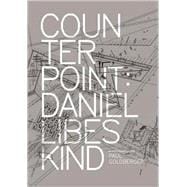
Note: Supplemental materials are not guaranteed with Rental or Used book purchases.
Purchase Benefits
What is included with this book?
Daniel Libeskind is the founder and principal of Studio Daniel Libeskind, founded in Berlin in 1989.
Paul Goldberger is the architecture critic for the New Yorker. He also holds the Joseph Urban Chair in Design and Architecture at the New School in New York City. He began his career at the New York Times, and in 1984, he was awarded the Pulitzer Prize for Distinguished Criticism. He is the author of several books, most recently his chronicle of the process of rebuilding Ground Zero, Up From Zero: Politics, Architecture, and the Rebuilding of New York. The author lives in New York.
| Counterpoint | |
| Libeskind in Conversation with | |
| Jewish Museum Berlin | |
| Germany Editoriale Bresciana Tower | |
| Italy Westside Shopping and Leisure Center | |
| Switzerland Haeundae Udong Hyundai I'Park | |
| South Korea Danish Jewish Museum | |
| Denmark The Ascent at Roebling's Bridge Covington | |
| Kentucky Extension to the Denver Art Museum | |
| Colorado Denver Art Museum Residences | |
| Colorado Military History Museum | |
| Germany Grand Canal Square Theatre and Commercial Development | |
| Ireland Roedingsmarkt | |
| Germany Creative Media Centre Hong Kong Riverstone | |
| South Korea Jerusalem Oriya | |
| Israel Reflections Keppel | |
| Singapore MGM Mirage CityCenter Las | |
| Nevada London Metropolitan University Graduate Centre London | |
| England Extension to the Victoria and Albert Museum London | |
| England Imperial War Museum North Manchester | |
| England Fiera Milano Milan | |
| Italy 18.36.54 New Milford | |
| Connecticut Memory Foundations New York | |
| New York New York Tower New York | |
| New York Felix Nussbaum Haus Osnabruck | |
| Germany Memoria e Luce Padua | |
| Italy Tour Signal | |
| La Defense Paris | |
| France Studio Weil Port d'Andratx | |
| Spain Proportion The Wohl Centre Ramat Gan | |
| Israel The Contemporary Jewish Museum San Francisco | |
| California Tangent Seoul | |
| South Korea Gazprom Headquarters St. Petersburg | |
| Russia Royal Ontario Museum Toronto | |
| Canada The L Tower and Sony Centre for the Performing Arts Toronto | |
| Canada Hermitage-Guggenheim Vilnius Museim Vilnius | |
| Lithuania Zlota 44 Warsaw, Poland Credits | |
| Table of Contents provided by Publisher. All Rights Reserved. |
The New copy of this book will include any supplemental materials advertised. Please check the title of the book to determine if it should include any access cards, study guides, lab manuals, CDs, etc.
The Used, Rental and eBook copies of this book are not guaranteed to include any supplemental materials. Typically, only the book itself is included. This is true even if the title states it includes any access cards, study guides, lab manuals, CDs, etc.
Excerpted from Counterpoint: Daniel Libeskind in Conversation with Paul Goldberger by Paul Goldberger, Daniel Libeskind
All rights reserved by the original copyright owners. Excerpts are provided for display purposes only and may not be reproduced, reprinted or distributed without the written permission of the publisher.